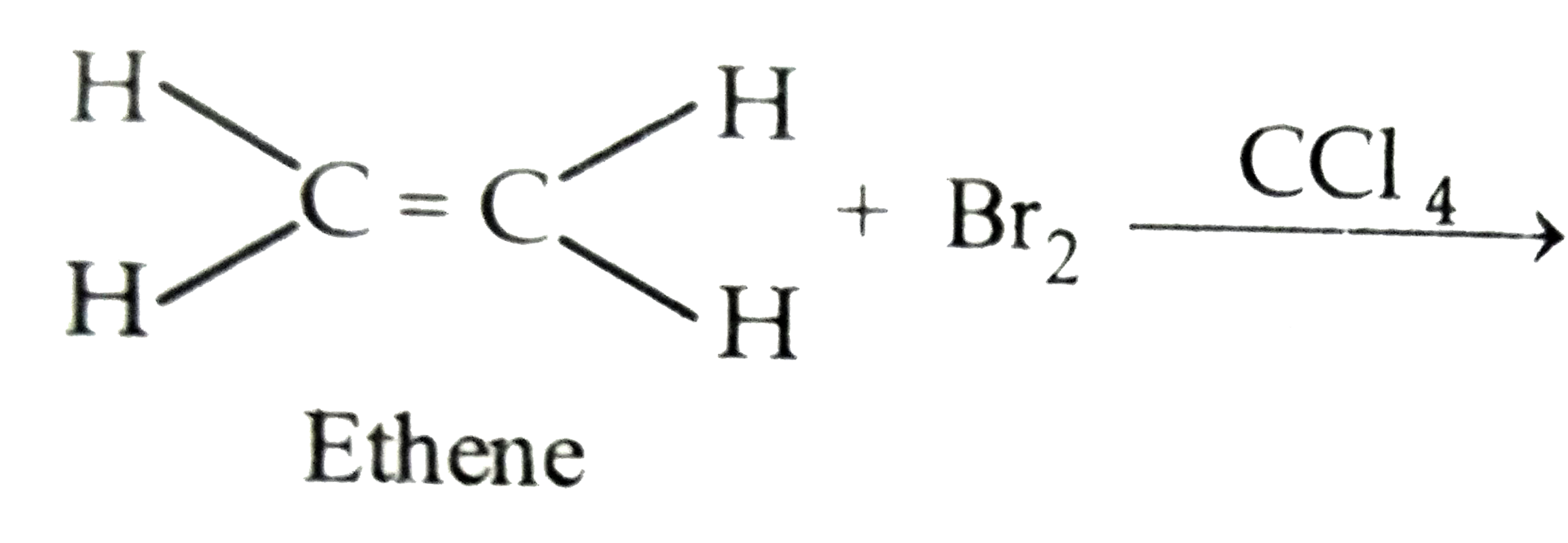Complete the following reaction equations:
(i) C6H5N2Cl+KI→ _____
(ii) C6H5−+N≡NCl−CuBr/HBr−−−−−−→
(iii) C6H5N+2Cl−Cu2Cl2/HCl−−−−−−−→
To complete the given reaction equations, we will analyze each reaction step by step.
(i) Reaction: C6H5N2Cl+KI
1. Identify the reactants: We have phenyl diazonium chloride (C6H5N2Cl) and potassium iodide (KI).
2. Recognize the leaving group: The diazonium group (N2+) is a good leaving group.
3. Substitution reaction: The iodide ion (I−) from potassium iodide will substitute the diazonium group.
4. Product formation: The product formed will be iodobenzene (C6H5I) and nitrogen gas (N2) will be released.
Final Equation:
\( C_{6}H_{5}N_{2}Cl + KI \rightarrow C_{6}H_{5}I + N_{2} + KCl \)
(ii) Reaction: C6H5−+N≡NCl−CuBr/HBr
1. Identify the reactants: We have phenyl diazonium chloride and copper(I) bromide in the presence of hydrobromic acid.
2. Recognize the leaving group: Again, the diazonium group (N2+) is a good leaving group.
3. Substitution reaction: The bromide ion (Br−) from copper(I) bromide will substitute the diazonium group.
4. Product formation: The product formed will be bromobenzene (C6H5Br) and nitrogen gas (N2) will be released.
Final Equation:
\( C_{6}H_{5}N_{2}^{+}Cl^{-} + CuBr \xrightarrow{HBr} C_{6}H_{5}Br + N_{2} + CuCl \)
(iii) Reaction: C6H5N+2Cl−Cu2Cl2/HCl
1. Identify the reactants: We have phenyl diazonium chloride and copper(I) chloride in the presence of hydrochloric acid.
2. Recognize the leaving group: The diazonium group (N2+) is a good leaving group.
3. Substitution reaction: The chloride ion (Cl−) from copper(I) chloride will substitute the diazonium group.
4. Product formation: The product formed will be chlorobenzene (C6H5Cl) and nitrogen gas (N2) will be released.
Final Equation:
\( C_{6}H_{5}N_{2}^{+}Cl^{-} + Cu_{2}Cl_{2} \xrightarrow{HCl} C_{6}H_{5}Cl + N_{2} + CuCl \)
Summary of Reactions:
1. \( C_{6}H_{5}N_{2}Cl + KI \rightarrow C_{6}H_{5}I + N_{2} + KCl \)
2. \( C_{6}H_{5}N_{2}^{+}Cl^{-} + CuBr \xrightarrow{HBr} C_{6}H_{5}Br + N_{2} + CuCl \)
3. \( C_{6}H_{5}N_{2}^{+}Cl^{-} + Cu_{2}Cl_{2} \xrightarrow{HCl} C_{6}H_{5}Cl + N_{2} + CuCl \)
2. Recognize the leaving group: The diazonium group (N2+) is a good leaving group.
3. Substitution reaction: The iodide ion (I−) from potassium iodide will substitute the diazonium group.
4. Product formation: The product formed will be iodobenzene (C6H5I) and nitrogen gas (N2) will be released.
\( C_{6}H_{5}N_{2}Cl + KI \rightarrow C_{6}H_{5}I + N_{2} + KCl \)
2. Recognize the leaving group: Again, the diazonium group (N2+) is a good leaving group.
3. Substitution reaction: The bromide ion (Br−) from copper(I) bromide will substitute the diazonium group.
4. Product formation: The product formed will be bromobenzene (C6H5Br) and nitrogen gas (N2) will be released.
\( C_{6}H_{5}N_{2}^{+}Cl^{-} + CuBr \xrightarrow{HBr} C_{6}H_{5}Br + N_{2} + CuCl \)
2. Recognize the leaving group: The diazonium group (N2+) is a good leaving group.
3. Substitution reaction: The chloride ion (Cl−) from copper(I) chloride will substitute the diazonium group.
4. Product formation: The product formed will be chlorobenzene (C6H5Cl) and nitrogen gas (N2) will be released.
\( C_{6}H_{5}N_{2}^{+}Cl^{-} + Cu_{2}Cl_{2} \xrightarrow{HCl} C_{6}H_{5}Cl + N_{2} + CuCl \)
1. \( C_{6}H_{5}N_{2}Cl + KI \rightarrow C_{6}H_{5}I + N_{2} + KCl \)
2. \( C_{6}H_{5}N_{2}^{+}Cl^{-} + CuBr \xrightarrow{HBr} C_{6}H_{5}Br + N_{2} + CuCl \)
3. \( C_{6}H_{5}N_{2}^{+}Cl^{-} + Cu_{2}Cl_{2} \xrightarrow{HCl} C_{6}H_{5}Cl + N_{2} + CuCl \)
Topper's Solved these Questions
- BOOK - PRADEEPCHAPTER - HALOALKANES AND HALOARENESEXERCISE - ADDITIONAL QUESTIONS (LONG ANSWER QUESTIONS)4videos
HALOALKANES AND HALOARENES
- BOOK - PRADEEPCHAPTER - HALOALKANES AND HALOARENESEXERCISE - HIGHER ORDER THINKING SKILLS ((QUESTIONS AND PROBLEMS WITH ANSWERS/SOLUTION)6videos
HALOALKANES AND HALOARENES
- BOOK - PRADEEPCHAPTER - HALOALKANES AND HALOARENESEXERCISE - ADDITIONAL QUESTIONS (VERY SHORT ANSWER QUESTIONS)64videos
HALOALKANES AND HALOARENES
- BOOK - PRADEEPCHAPTER - GENERAL PRINCIPLES AND PROCESSES OF ISOLATION OF ELEMENTS EXERCISE - Curiosity Questions2videos
GENERAL PRINCIPLES AND PROCESSES OF ISOLATION OF ELEMENTS
- BOOK - PRADEEPCHAPTER - ORGANIC COMPOUNDS CONTAINING NITROGENEXERCISE - IMPORTANT QUESTIONS FOR BOARD EXAMINATION27videos
ORGANIC COMPOUNDS CONTAINING NITROGEN
Similar Questions
Knowledge Check
- Question 1 - Select One
Product of the following reaction is C6H5−N2Cl+C6H5−NH2→
A B
B C
C D
D
Complete the following reaction equation :
C6H5N2Cl+H3PO2+H2O→.....View SolutionComplete the following equation:
(i). C6H5N2Cl+Ki→
(ii). H2C=CH2+Br2CCl4−−→View SolutionComplete the following reaction equations :
(i) C6H5N2Cl+H3PO2+H2O→
(ii)C6H5NH2+Br2(aq.)→View SolutionComplete the following reactions :
C6H5N2Cl+H3PO2+H2O→View SolutionComplete the following reaction equations :
(i) C6H5N2Cl+CH3COCl→
(ii) C2H5NH2+C6SO2Cl→
(iii) C2H5NH2+HNO2→View SolutionComplete the following reactions :
C6H5N2Cl(i)HBF4−−−−−−−−−−−−−→(ii)NaNO2/Cu,ΔView Solution(a) Complete the following reactions:
(i) C6H5NH2+CHCl3+KOH(alc.)warm−−→
(ii) C6H5N2−Cl− Cu2Cl2,HCl−−−−−−−→
(b) Write coupling reaction.View Solution


